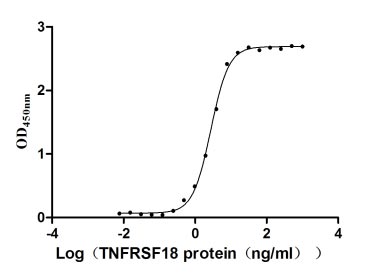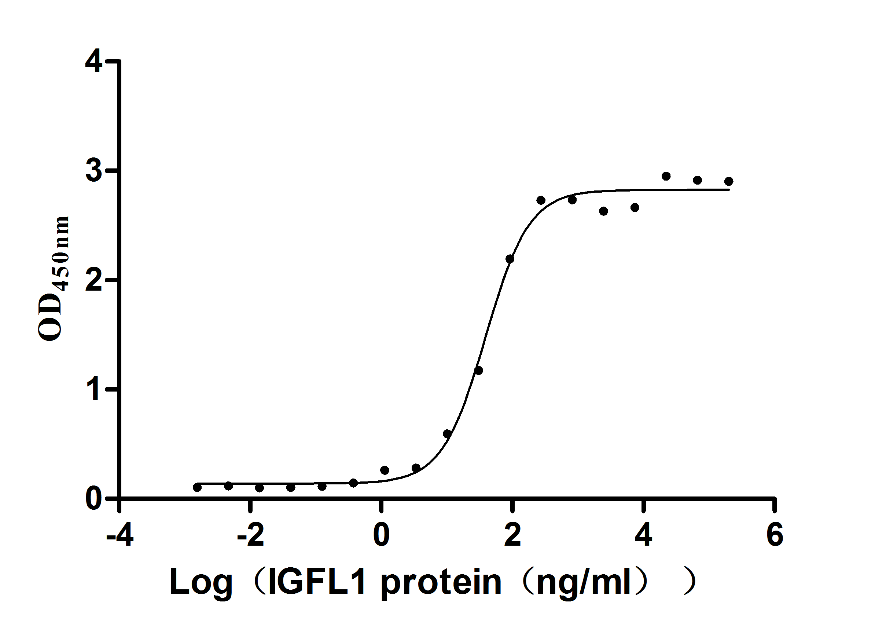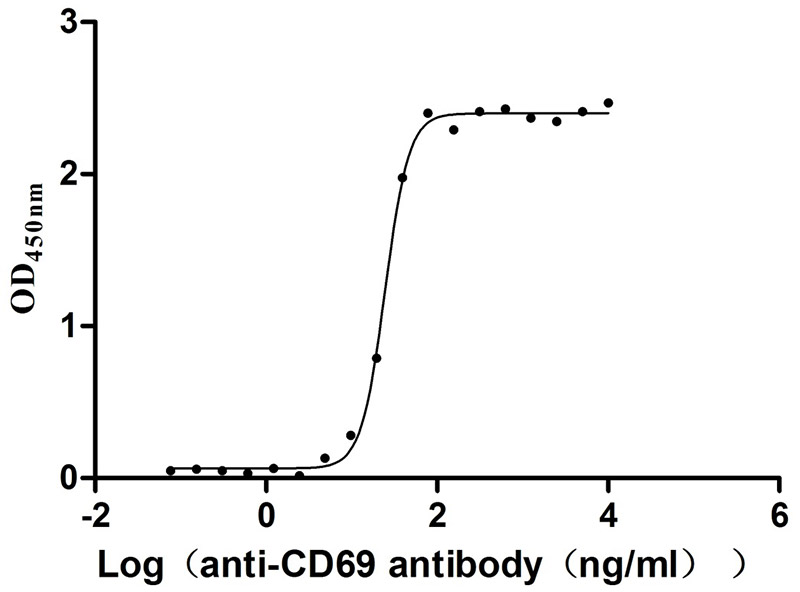Recombinant Rat Proprotein convertase subtilisin/kexin type 9 (Pcsk9)
-
货号:CSB-YP017647RA
-
规格:
-
来源:Yeast
-
其他:
-
货号:CSB-EP017647RA
-
规格:
-
来源:E.coli
-
其他:
-
货号:CSB-EP017647RA-B
-
规格:
-
来源:E.coli
-
共轭:Avi-tag Biotinylated
E. coli biotin ligase (BirA) is highly specific in covalently attaching biotin to the 15 amino acid AviTag peptide. This recombinant protein was biotinylated in vivo by AviTag-BirA technology, which method is BriA catalyzes amide linkage between the biotin and the specific lysine of the AviTag.
-
其他:
-
货号:CSB-BP017647RA
-
规格:
-
来源:Baculovirus
-
其他:
-
货号:CSB-MP017647RA
-
规格:
-
来源:Mammalian cell
-
其他:
产品详情
-
纯度:>85% (SDS-PAGE)
-
基因名:
-
Uniprot No.:
-
别名:Pcsk9; Narc1; Proprotein convertase subtilisin/kexin type 9; EC 3.4.21.-; Neural apoptosis-regulated convertase 1; NARC-1; Proprotein convertase 9; PC9; Subtilisin/kexin-like protease PC9
-
种属:Rattus norvegicus (Rat)
-
蛋白长度:Full Length of Mature Protein
-
表达区域:152-691
-
氨基酸序列SIPWNLERI IPAWQQTEED SSPDGSSQVE VYLLDTSIQS GHREIEGRVT ITDFNSVPEE DGTRFHRQAS KCDSHGTHLA GVVSGRDAGV AKGTSLHSLR VLNCQGKGTV SGTLIGLEFI RKSQLIQPSG PLVVLLPLAG GYSRILNTAC QRLARTGVVL VAAAGNFRDD ACLYSPASAP EVITVGATNA QDQPVTLGTL GTNFGRCVDL FAPGKDIIGA SSDCSTCYMS QSGTSQAAAH VAGIVAMMLN RDPALTLAEL RQRLILFSTK DVINMAWFPE DQRVLTPNRV ATLPPSTQET GGQLLCRTVW SAHSGPTRTA TATARCAPEE ELLSCSSFSR SGRRRGDRIE AIGGQQVCKA LNAFGGEGVY AVARCCLLPR VNCSIHNTPA ARAGPQTPVH CHQKDHVLTG CSFHWEVENL RAQQQPLLRS RHQPGQCVGH QEASVHASCC HAPGLECKIK EHGIAGPAEQ VTVACEAGWT LTGCNVLPGA SLPLGAYSVD NVCVARIRDA GRADRTSEEA TVAAAICCRS RPSAKASWVH Q
-
蛋白标签:Tag type will be determined during the manufacturing process.
The tag type will be determined during production process. If you have specified tag type, please tell us and we will develop the specified tag preferentially. -
产品提供形式:Lyophilized powder
Note: We will preferentially ship the format that we have in stock, however, if you have any special requirement for the format, please remark your requirement when placing the order, we will prepare according to your demand. -
复溶:We recommend that this vial be briefly centrifuged prior to opening to bring the contents to the bottom. Please reconstitute protein in deionized sterile water to a concentration of 0.1-1.0 mg/mL.We recommend to add 5-50% of glycerol (final concentration) and aliquot for long-term storage at -20℃/-80℃. Our default final concentration of glycerol is 50%. Customers could use it as reference.
-
储存条件:Store at -20°C/-80°C upon receipt, aliquoting is necessary for mutiple use. Avoid repeated freeze-thaw cycles.
-
保质期:The shelf life is related to many factors, storage state, buffer ingredients, storage temperature and the stability of the protein itself.
Generally, the shelf life of liquid form is 6 months at -20°C/-80°C. The shelf life of lyophilized form is 12 months at -20°C/-80°C. -
货期:Delivery time may differ from different purchasing way or location, please kindly consult your local distributors for specific delivery time.Note: All of our proteins are default shipped with normal blue ice packs, if you request to ship with dry ice, please communicate with us in advance and extra fees will be charged.
-
注意事项:Repeated freezing and thawing is not recommended. Store working aliquots at 4°C for up to one week.
-
Datasheet :Please contact us to get it.
相关产品
靶点详情
-
功能:Crucial player in the regulation of plasma cholesterol homeostasis. Binds to low-density lipid receptor family members: low density lipoprotein receptor (LDLR), very low density lipoprotein receptor (VLDLR), apolipoprotein E receptor (LRP1/APOER) and apolipoprotein receptor 2 (LRP8/APOER2), and promotes their degradation in intracellular acidic compartments. Acts via a non-proteolytic mechanism to enhance the degradation of the hepatic LDLR through a clathrin LDLRAP1/ARH-mediated pathway. May prevent the recycling of LDLR from endosomes to the cell surface or direct it to lysosomes for degradation. Can induce ubiquitination of LDLR leading to its subsequent degradation. Inhibits intracellular degradation of APOB via the autophagosome/lysosome pathway in a LDLR-independent manner. Involved in the disposal of non-acetylated intermediates of BACE1 in the early secretory pathway. Inhibits epithelial Na(+) channel (ENaC)-mediated Na(+) absorption by reducing ENaC surface expression primarily by increasing its proteasomal degradation. Regulates neuronal apoptosis via modulation of LRP8/APOER2 levels and related anti-apoptotic signaling pathways.
-
基因功能参考文献:
- up-regulation of intestinal gene expression of LDL-R and PCSK9 following voluntary wheel running PMID: 29938676
- This is the first report about the expression of PCSK9 in adult terminal differentiated ventricular cardiomyocytes PMID: 28913715
- PCSK9 is regulated in vascular smooth muscle cells by TLR-4 - SAPK/JNK signaling, a pathway important in inflammation and metabolism. PMID: 28232185
- Hnf1alpha gene expression is upregulated in the liver of rats with experimentally induced chronic renal failure, showing an association between circulating PCSK9 and TAGs PMID: 26978583
- PCSK9 could serve as a novel molecular biomarker for the non-invasive prenatal screening of neural tube defects. PMID: 26691006
- coordinated up-regulation of Pcsk9 and Srebf-2 genes expression suggests that SREBF-2 may play a key role in regulation of Pcsk9 gene expression, circulating PCSK9 level, and hypercholesterolemia in experimental CRF PMID: 26481479
- LDLR deficiency, hypercholesterolemia and elevated plasma LDL in NS are associated with upregulation of PCSK9 and IDOL. PMID: 24166456
- Gene expression of hepatic LDL-R, Lrp1, Pcsk9, SREBP-2 and HMGCoA-r were reduced (p<0.05) in ovariectomy compared to Sham rats. PMID: 24619822
- data provided the first line of the evidence that BBR, similar to the Sim, could increase the expression of PCSK9 levels in HFD rats through SREBP-2 activation PMID: 24755036
- Elevated serum PCSK9 concentration by ezetimibe, Xuezhikang and pitavastatin alone or in combination was found prior to the alterations of lipid profile in rats. PMID: 24533584
- Phaleria macrocarpa fruit aqueous extract reduced body weight/improved blood lipid profile of hypercholesterolemic rats. The improvement is likely to be regulated by LDL receptor and PCSK9. PMID: 21763412
- Our functional characterization of Narc 1 reinforces the inference drawn that this enzyme is most closely related to representatives of the proteinase K family, but it is also sufficiently different to warrant its classification in a separate sub-family. PMID: 14622975
- Human, mouse, and rat PCSK9 promoters contain 2 typical conserved motifs for cholesterol regulation: a sterol regulatory element (SRE) and an Sp1 site. PMID: 15178557
- Proprotein convertase subtilisin/kexin type 9 (PCSK9) is processed in the Endoplasmic Reticulum, and the mature convertase is secreted in the plasma. PMID: 16462892
- mechanism by which NARC 1 overexpression induces cell death in cerebellar granule neurons remains unclear; correlation seen between Narc 1 active site serine in transiently expressed protein and induction of BAF-sensitive component of cell death phenotype PMID: 17051583
- explaining the lack of reduction in LDL receptor protein levels. These observations indicate that the rate of LDL receptor cycling (function) in diabetic rats is decreased resulting in higher serum LDL levels. PMID: 18054320
- The hormonal and dietary regulation of hepatic LDLRs also involves posttranscriptional regulation by PCSK9. PMID: 19008317
- NARC-1 is a proteinase K-like subtilase with a role in the differentiation of cortical neurons. PMID: 12552133
显示更多
收起更多
-
亚细胞定位:Cytoplasm. Secreted. Endosome. Lysosome. Cell surface. Endoplasmic reticulum. Golgi apparatus.
-
蛋白家族:Peptidase S8 family
-
组织特异性:Highly expressed in 12-day embryo. In the adult, strongly expressed in liver, small intestine, jejunum, and to a lesser extent in kidney, lung, spleen and thymus. Expression in the liver is up-regulated following partial hepatectomy.
-
数据库链接:
KEGG: rno:298296
STRING: 10116.ENSRNOP00000008536
UniGene: Rn.19195
Most popular with customers
-
Recombinant Human Tumor necrosis factor receptor superfamily member 18 (TNFRSF18), partial (Active)
Express system: Mammalian cell
Species: Homo sapiens (Human)
-
Recombinant Human IGF-like family receptor 1 (IGFLR1), partial (Active)
Express system: Mammalian cell
Species: Homo sapiens (Human)
-
Recombinant Human Early activation antigen CD69 (CD69), partial (Active)
Express system: Mammalian cell
Species: Homo sapiens (Human)
-
Recombinant Rat Gastric inhibitory polypeptide receptor (Gipr), partial (Active)
Express system: Mammalian cell
Species: Rattus norvegicus (Rat)
-
Recombinant Human Serotransferrin(TF) (Active)
Express system: Mammalian cell
Species: Homo sapiens (Human)
-
Recombinant Human CD70 antigen (CD70), partial (Active)
Express system: Mammalian cell
Species: Homo sapiens (Human)
-
Recombinant Human Gastric inhibitory polypeptide receptor(GIPR),partial (Active)
Express system: Mammalian cell
Species: Homo sapiens (Human)
-
Recombinant Macaca fascicularis Cadherin 6(CDH6),partial (Active)
Express system: Mammalian cell
Species: Macaca fascicularis (Crab-eating macaque) (Cynomolgus monkey)




















